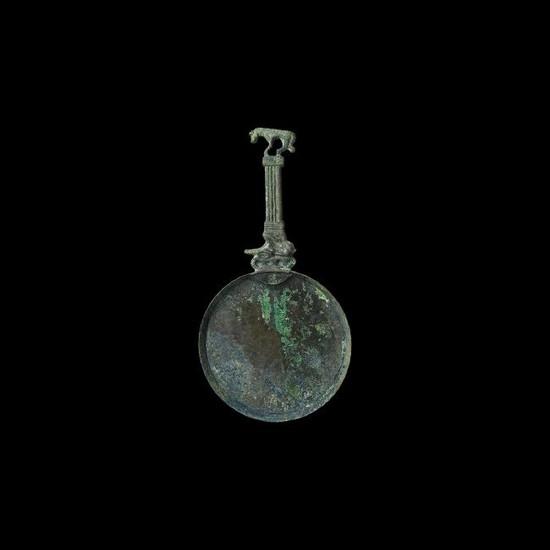Large Scythian Mirror with Stag and Feline
5th-4th century BC. A bronze mirror of Scythian-Olbian type comprising a round face with reflective surface; handle with figure of a running stag with large antlers resting on the back; fluted column below with standing feline finial modelled in the round. Cf. Trofimova, A. Greeks on the Black Sea: ancient art from the Hermitage, J.Paul Getty Museum, 2007, item 29j; see Leypunskaya, N. A. Olbian-Scythian Trade: Exchange Issues in the Sixth to Fourth Centuries BC, Oxford, 2007, for discussion. 842 grams, 34cm (13 1/4"). Property of a European businessman; from his private Belgian collection formed in the 1990s; previously in a North American collection formed in Illinois in the 1980s. The so-called 'Olbian type' mirror is named after the Greek city Olbia, which appears to have had a dynamic commercial exchange with the Scythian world between the sixth and fourth centuries BC. The Olbian mirrors are recognised as central to this trade network and their origin has been widely discussed by the academic community. It remains disputed whether the mirrors were made by Scythians near the River Dnieper, or whether they were Olbian. Leypunskaya (2007) suggests that Olbian bronzework, including these mirrors, was created for trade with Scythians, drawing on popular animal-style designs to target a Scythian audience. [A video of this item is available to view on TimeLine Auctions website.]
Condition Report: Very fine condition. Rare.
View it on
Estimate
Time, Location
Auction House
5th-4th century BC. A bronze mirror of Scythian-Olbian type comprising a round face with reflective surface; handle with figure of a running stag with large antlers resting on the back; fluted column below with standing feline finial modelled in the round. Cf. Trofimova, A. Greeks on the Black Sea: ancient art from the Hermitage, J.Paul Getty Museum, 2007, item 29j; see Leypunskaya, N. A. Olbian-Scythian Trade: Exchange Issues in the Sixth to Fourth Centuries BC, Oxford, 2007, for discussion. 842 grams, 34cm (13 1/4"). Property of a European businessman; from his private Belgian collection formed in the 1990s; previously in a North American collection formed in Illinois in the 1980s. The so-called 'Olbian type' mirror is named after the Greek city Olbia, which appears to have had a dynamic commercial exchange with the Scythian world between the sixth and fourth centuries BC. The Olbian mirrors are recognised as central to this trade network and their origin has been widely discussed by the academic community. It remains disputed whether the mirrors were made by Scythians near the River Dnieper, or whether they were Olbian. Leypunskaya (2007) suggests that Olbian bronzework, including these mirrors, was created for trade with Scythians, drawing on popular animal-style designs to target a Scythian audience. [A video of this item is available to view on TimeLine Auctions website.]
Condition Report: Very fine condition. Rare.



